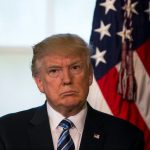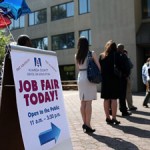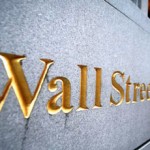The honeymoon is over: Wall Street is finally taking Trump literally

By itself, the 230-point drop in the Dow Jones Industrial Average DJIA, -0.16% this week wasn’t earth shattering: 1% gains and losses happen all the time. But the clattering sound accompanying it wasn’t hard to diagnose: It was the sound of scales falling off of Wall Street’s eyes.
The market this week is dealing with the realization that President Donald Trump means all the things he says. He really is a protectionist, really does think America needs to be protected from the world both economically and physically. He really does make policy without much care or thought to get details right, he really has recruited an honest-to-God terrible team, and it actually is kind of dangerous.
For months, Wall Street strategists scrambled to justify a post-election rally most didn’t see coming by claiming Trump’s proposed tax cuts and vague infrastructure spending plans would goose growth, while discounting his vow to impose trade barriers as not really serious. Ten days into his presidency, the president has alienated our third-biggest trading partner in Mexico while having his spokesman float vague proposals about 20% taxes the president himself says might apply to all imports.
And the rally goes thump. Not quite a crash, certainly not yet.
But the combination of the flirtation with new trade barriers — there’s no bill introduced in Congress yet to make them real — and this past weekend’s bar on immigration or even visitors from seven mostly-Muslim nations makes clear that Trump really means to do as he says.
And the Keystone Kops nature of how he fired Acting Attorney General Sally Yates, for refusing to defend the immigration order in court, along with the head of Immigration and Customs Enforcement, makes clear that inmates led by presidential counselor Steve Bannon now run the asylum.
The economy is already showing that it’s the same 2% to 2.5% annual growth engine it has been since the 2008 financial crisis, no matter what the president tweets about his having brought hope for 4% growth. The Commerce Department’s first estimate of fourth-quarter growth showed it at an annual rate of 1.9%, down from 3.5% in the third quarter. Moody’s Analytics is warning that its call for a first-quarter pickup is at risk after a weak December report on consumer spending, which isn’t matching reported gains in consumer confidence.
Wage growth is slowing too, according to the employment cost index release Monday. “Up just 2.2% in past year,” liberal economist Dean Baker says, with a pickup in inflation to boot. “Why is [the] Fed raising interest rates?”
The rally was based on assumptions, embedded in reports from banks like Goldman Sachs and Bank of America Merrill Lynch, that Trump’s tax cuts and infrastructure plans would boost growth — and that he wouldn’t go ahead with trade policies that would erase the gains, or would water them way down. Now, congressional Republicans are balking at infrastructure plans, and a determination to create a deglobalized America is taking precedence.
Bad combination. Shame on Wall Street for selling a cake-and-candy version of it.
Late-fall gains in consumer confidence helped fool Wall Street, but they were Twitter gold: The surge in the numbers in Gallup’s confidence surveys, at least, just reflected gains in the confidence of people who voted for Trump. The Conference Board reported Tuesday that consumer confidence dropped in January after hitting a 15-year high in December.
The other grain of salt is that expectations were last this high in 2001, when the economy had just entered a recession consumers didn’t yet feel. But evidence was piling up during the quarter that consumers weren’t spending much — and the Street mostly ignored it.
This is what the market has to grapple with now: Whether a combination of immaturity, surreality and stubborn refusal to engage with (indeed, an open desire to roll back) economic changes that have been underway for decades — and which have already lifted 1 billion people out of extreme poverty worldwide — is really good for creating a stable market for investment and promoting growth.
And whether Wall Street will really confront its own little bout of post-election surreality, in which it conjured up an economic rally that wasn’t there to justify a stock rally that had ended by the time I pointed out the disparity.
Spectacle is bad for business. Sometimes the spectacle is Trump obsessing over his inaugural crowd, or his habitual lying. Last night, it was sweeping out Yates for defending the rule of law. This morning, it’s the amusing sight of a spokesman for Queen Elizabeth trying to wriggle out of the state visit British Prime Minister Theresa May invited Trump to make.
Today’s real problem is Trump trade adviser Peter Navarro crudely trying to manipulate currency markets, calling the euro “grossly undervalued” in what looks like a bid to undo damage Trump does with policies that pump up the dollar and threaten U.S. exports. Navarro also decided to lecture the Financial Times about how global supply chains are a bad thing, despite decades of practice by executives who know their businesses far better than Navarro does.
“It’s amateur hour,” said Joe Brusuelas, chief economist at management consultancy RSM US. “Euro grossly overvalued? Repatriation of U.S. supply chain? That way lies perdition. Pun intended.”
Yes, it is. But at some point, which we can’t yet see from here, amateur hour may devolve into a Creamsicle Swan, the kind of unpredictable negative event presidential tantrums can cause.
A struggle between the essential stability of the U.S. economy and the 11-day old instability of its political institutions is being joined before our eyes. The path of the market hangs in the balance.
Source: MarketWatch





























